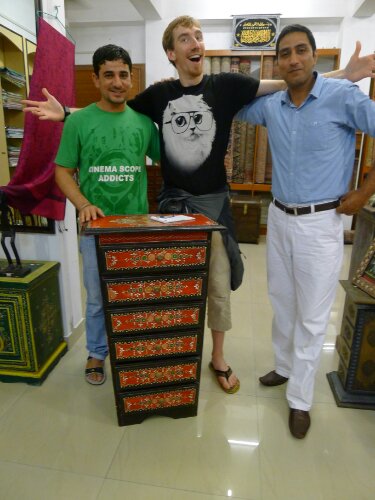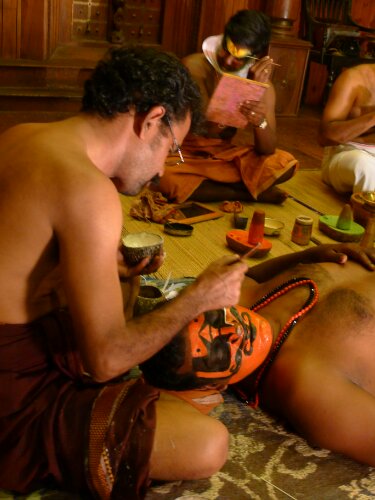At last, a day in which our umbrellas went unused! Christine said that Kochi was described to her as having “Door County charm” and she was right – we saw plenty of tourists in the Fort Cochin area probably for that very reason. Our hotelier recommended an A/C bus to us for getting from our lodgings at the edge of Ernakulum in the mainland city, but of course we were unable to find it and we had to take a regular city bus for the 15km trip – which ended up taking over an hour and a half!
We had brunch at this wonderful little restaurant that Christine’s sister had recommended to us, the Kashi Art Gallery. It was off on a little side street, surrounded by other restaurants and their attendants who hailed us repeatedly to come and eat with them. However, the Kashi had posted arrowed signs up in several spots so despite it being off the beaten track it was fairly easy to find. As it’s one of the highest rated restaurants on several travel websites, it probably is not well liked by its local competitors. Inside it reminded us a lot of the hotel we had stayed in San Jose, Costa Rica two years ago – a main building with a series of disconnected roofs out back that diners could eat underneath. And we arrived just in time, the (only) rain of the day fell as we were eating omelettes and pumpkin soup.
We strolled down bazaar lane, looking for the two main tourist attraction buildings, something called the Mattencherry Palace and the other, the oldest Jewish synagogue in India, created only a few decades after the fall of Jerusalem when a boatload of Jews arrived on the coast, offering gifts to the local raja and requesting asylum. We found it nestled into the old brick and stone hovels of “the jewtown” as it’s referred to in guidebooks. A scant few of the buildings are the century old originals, with faded Hebrew lettering above their lintels and with stars of David etched into their roofs. The synagogue was only 5 rupees to enter, but no photography was allowed. A single room with mirrored walls, hanging glass lanterns and the large wall hanging at the alter greeted us – not beautiful, but reverential and functional, which is what I’m sure the original congregation would have called it too. There are now only 70 Jews left in all of India, and only 6-7 in Kerala, according to a sign on the wall. They didn’t say whether anyone worshipped at this ancient temple anymore.
After another hour of walking down the lane (I fed a goat who was straining so hard for a plant growing just out of reach on a bridge that he was about to fall in) and we gave up on finding Mattencherry ourselves and hired a rickshaw driver – the first female driver we had seen, a young woman who was wearing a beige official looking uniform. I wondered if she was like the mythological female taxi drivers in Amman who only gave rides to women (there were supposedly a half dozen when I lived there) but she was amiable to taking both of us to the palace. As with the national history museum in Mumbai, I was impressed with the level of detailed description on all of the artifacts, especially on the dozen plaques talking about the Cochi royal family as it had existed before British rule, during, and even afterward (several are lawyers, and then others are teachers and accountants). The palace’s crowning beauty are the 2 meter tall wall murals made in 1300, telling the story of the Ramayana – Rama being an incarnation of Vishnu who had an adventure to reclaim his paramour Sita from a demon who had captured her. They were beautiful, but quite hard to read and comprehend – besides being faded and worn in many spots, the Hindu style of artistry used involved cramming as many people, demons and other objects into as small of panels as possible. Thankfully there was a guide on each panel telling us where to look for each particular event.
On Bazaar Road, there were also some amazing antique shops – including one owned by some Kashmiris that were able to get me hook, line, and sinker. We were walking through it, ignoring their touts as we saw the usual stone carving, wood carving, sari, and jewelry. Christine and I both admired a handsome meter-high chest of drawers painted garishly in beautiful red and black motifs. In the end, before the Kashmiris won me over I was able to talk them down to $450, including the cost of packaging, insuring, and shipping to Milwaukee. They had originally wanted almost $700 for it, so I view it as a well-haggled investment. Now I just have to find somewhere to put it when it arrives at the port of Milwaukee…

The guy in the blue said his name was "Happiness" in English but Christine thinks he was just relieved to move a piece of furniture in the tourist off-season
The final event of the evening was a Kathakali “face dance” – the traditional Keralan theatre. The place was jam packed with tourists, more than I’d seen in one place before. The show technically began at 5, as the doors opened to let us in – each actor applied their own makeup by hand. As you can see from the video linked here (I didn’t take any of mine because judging from the sound of dozens of cameras digitally clicking around me, this show doesn’t suffer from obscurity on the internet) the actors are painted in various elaborate patterns – green for Bhima the warrior prince, and red for the demon who needs to be slain. The yellow-faced priest who helps Bhima is also the person who does the demonstration of the special movements for the audience (the video is the same performer and musician we had). The two mock and taunt each other with words, true, but the “face” part of face dance comes from distinct eye, mouth, nose, and face muscular twitches that the actors train for years to be able to accomplish. Christine told me that apparently no Kathakali actors have ever needed to wear glasses, even when their in their senior years – the eye muscles are so taut and strong that they’re simply not needed. Meanwhile, as the two battle on stage in slow motion, a frantic pair of drummers and a warbling singer keep the beat on the side of the stage, all bare-chested and wearing dhotis and beads.

Well, not ALL makeup - the actors can do 75% of it but then a specialist fine-tunes the tiny intricate bits
It was pretty late when we got out, and we didn’t want to risk another hour and a half long bus ride back to Ernakulum from Fort Kochi. So we walked a short distance to a ferry jetty that ended up taking 7 minutes to transport us across the harbor (and 4 rupees apiece instead of 15) the same distance would have taken 45 minutes on the bus. We past some massive warships and freighters in the harbor, too – apparently the Indian Navy does a lot of work out of Kochi.
Now we’re on our way to the Cochi Airport, a 23km car ride. It’s an early flight at 8am, and Christine is asleep again already in the seat next to me. But we both knew that leaving at 5:30 in the morning was the safest option; you can never count on India to get you anywhere at the estimated time, so better safe than sorry.



No one has commented on this post - please leave me one, I love getting feedback!
Follow this post's comments, or leave a Trackback from your site